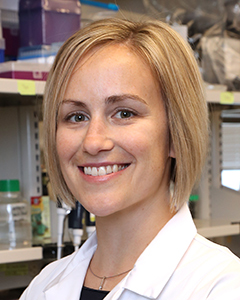
Monica LARONDA (USA)
Monica M. Laronda PhD earned her doctorate in Life Sciences in the laboratory of J. Larry Jameson, MD, PhD in Northwestern University’s Department of Medicine, Division of Endocrinology, while studying the role of Sox3 (sex-determining region-Y box gene 3) on spermatogonial differentiation. Dr. Laronda’s postdoctoral appointment was under the guidance of Teresa K Woodruff, PhD where she investigated the extracellular matrix (ECM) compartments within the ovary, how these affect the growth and viability of isolated granulosa cells and ovarian follicles and how to use natural ECM or biomimetic scaffolds to create an engineered ovary. Dr. Laronda was awarded the Burroughs Wellcome Fund Career Award at the Scientific Interface for her work in the Woodruff Lab on developing an engineered ovary using 3D printing. This award provides continued support in her independent laboratory. Dr. Laronda was hired as the Director of Foundational and Translational Research for the Fertility & Hormone Preservation & Restoration Program at the Ann & Robert H. Lurie Children's Hospital of Chicago in 2016. She is the Warren & Eloise Batts Scholar at the Stanley Manne Children's Research Institute and Assistant Professor in the Department of Pediatrics at the Feinberg School of Medicine at Northwestern University.
Abstract
3D Ovary
There are several patient groups that desire restoration of ovarian function for hormones and/or fertility. These groups include patients with idiopathic, genetic, or chemically-induced reduction in ovarian function, such as cancer survivors whose life-saving treatments caused a decline in their ovarian reserve. Therefore, women or girls who desire fertility preservation, but cannot be hormonally stimulated to produce and cryopreserve eggs prior to a potentially sterilizing treatment or progression of disease, can opt to remove and cryopreserve ovarian tissue. To date, there have been >130 reported live births following transplantation of the preserved ovarian tissue. However, there is a risk of reintroducing disease and ovarian tissue transplants often provide a narrow window of restored natural fertility and hormone function. The oocyte (potential egg cell) is supported through the maturation process by granulosa (hormone producing) cells, which proliferate and differentiate upon activation and the oocyte and granulosa cells together create a spherical unit (follicle). Extracellular matrix and associated proteins, together referred to as the matrisome, provide mechanical and biological cues and create compartments that separate the finite pool of ovarian reserve follicles from the activated follicles. Our objective is to create a bioprosthetic ovary that can restore long-term function. We tested several scaffold designs of 3D printed gelatin to optimize ovarian follicle survival and function. We have implanted an ovariectomized mouse with 60° 3D printed scaffolds seeded with green fluorescent protein (GFP)-positive quiescent primordial and growing primary and secondary murine follicles. These bioprosthetic ovaries supported vascular infiltration without the addition of angiogenic factors, restored the estrous cycle and produced live offspring. To translate this bioprosthetic to humans, we are focusing our investigations on the native matrisome and cues that it provides to the ovarian reserve. To this end we have mapped the distribution of matrisome proteins in the porcine ovary. We identified 317 proteins that were statistically significantly differentially (FDR <0.01) expressed across different depths of the ovary. We are beginning to elucidate the role of these proteins on folliculogenesis using an ex vivo culture system. These initial results underscore the importance of the bioactive scaffold architecture in supporting folliculogenesis and our current investigations will lead to an informed scaffold design that can replace potentially metastatic tissue and provide sustained fertility and ovarian hormone support.
